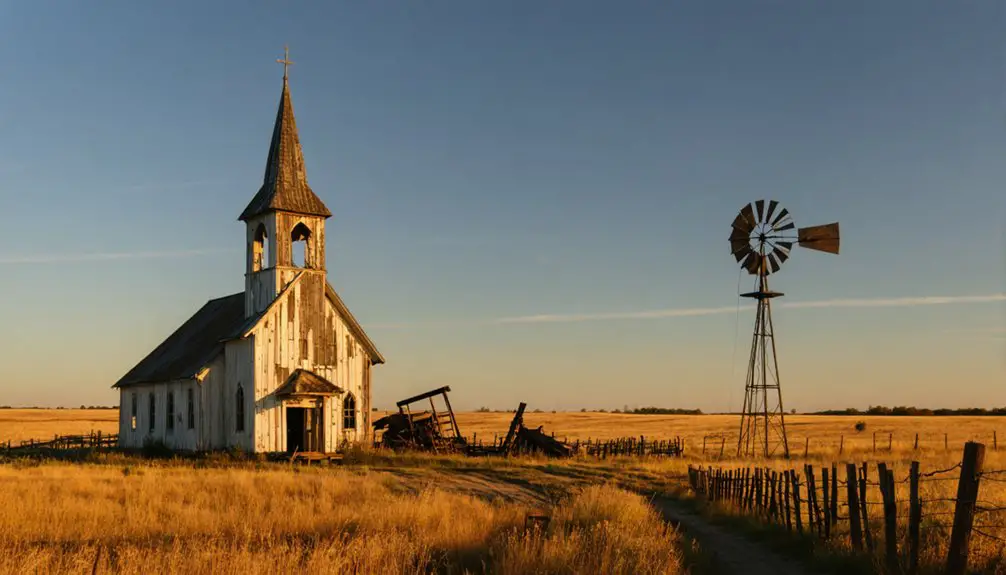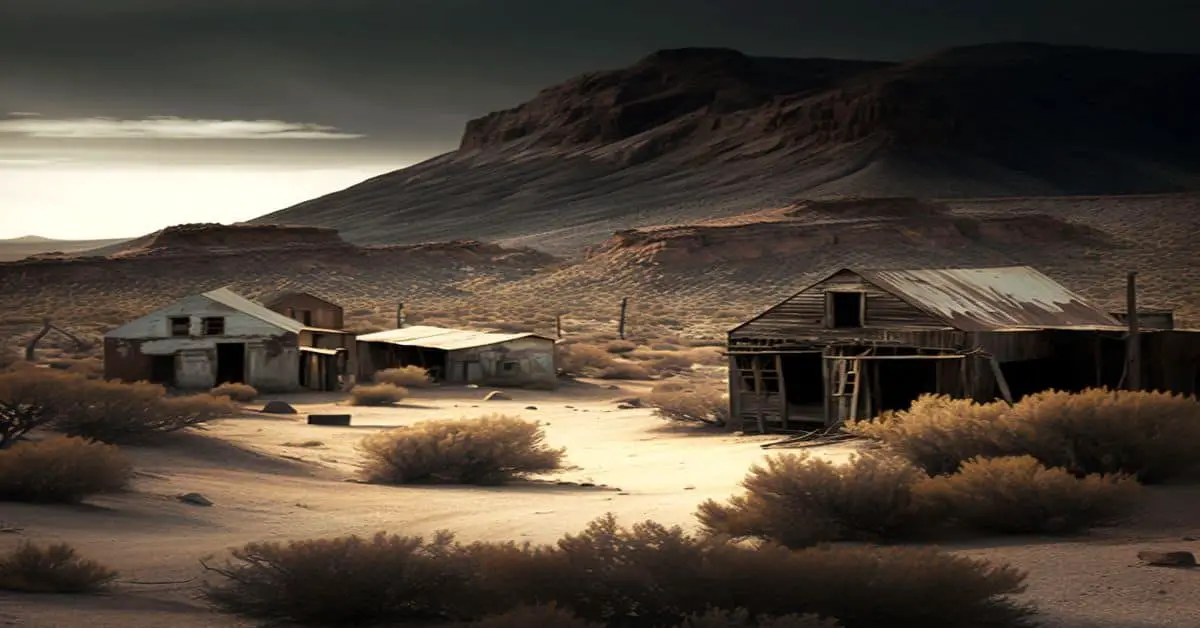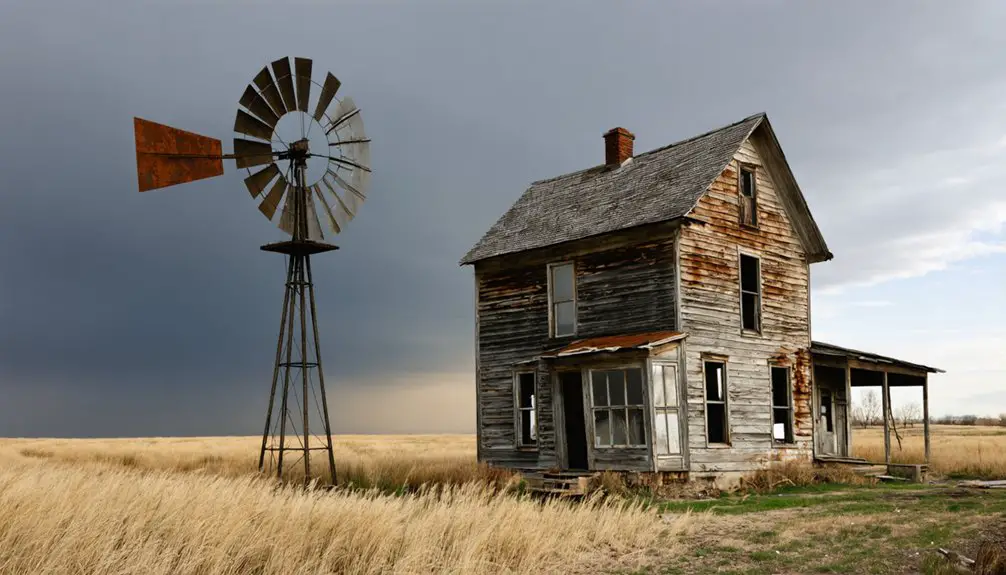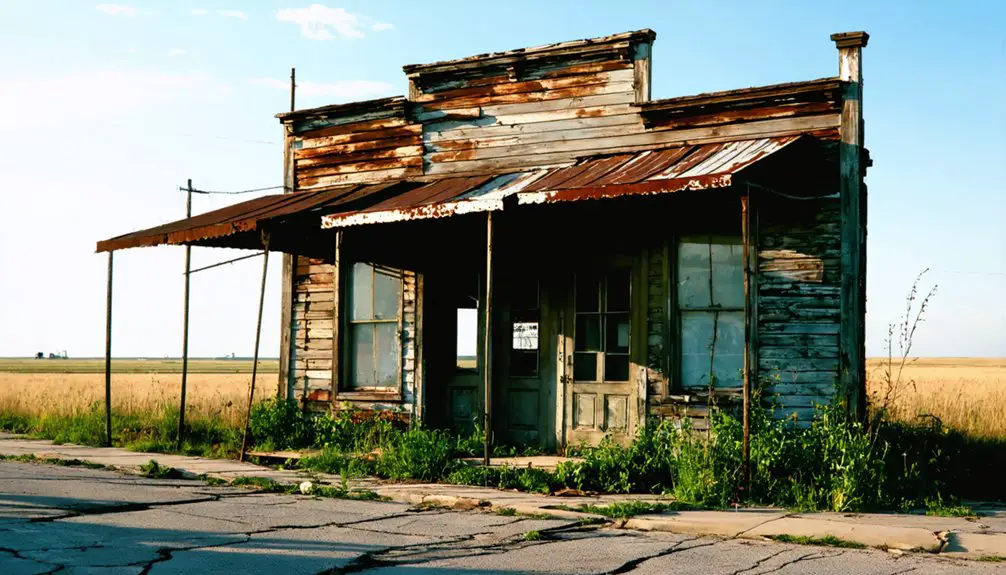You’ll find Glen, Nebraska nestled along the former Chicago, Burlington and Quincy Railroad line, established in 1889 as a strategic trade hub. This ghost town once bustled with merchants, farmers, and rail travelers, featuring a jail, rural schoolhouse, and various commercial buildings serving the agricultural community. After the railroad’s discontinuation and agricultural mechanization transformed the region, Glen gradually emptied. Today, hiking trails wind through the ruins, where nature steadily reclaims what civilization left behind.
Key Takeaways
- Glen was established in 1889 along the Chicago, Burlington and Quincy Railroad line, serving as a minor trade hub for local agriculture.
- The town featured essential structures including a jail, rural schoolhouse, and general stores supporting both residents and railroad travelers.
- District 57 schoolhouse, founded in 1882, operated until mid-20th century and is now preserved by the Orchard Historical Society.
- Glen’s decline began with railroad service discontinuation, agricultural mechanization, and consolidation of smaller farms into larger operations.
- Today, the ghost town site contains hiking trails along former railbeds, with visible ruins and artifacts amid nature’s reclamation.
Railroad Roots and Early Settlement
When the Chicago, Burlington and Quincy Railroad extended its line from Alliance, Nebraska, to Edgemont, South Dakota in 1889, it set the stage for Glen’s establishment along this significant transportation corridor.
Like many frontier settlements, you’ll find Glen’s origins deeply rooted in railroad expansion patterns that shaped northwest Nebraska’s development.
You couldn’t have settled this region without the railroad’s lifeline. As the Burlington line pushed northward, it brought essential supplies, workers, and economic opportunities.
The railroad transformed transportation by reducing travel costs to one-tenth previous rates, making the settlement of towns like Glen economically viable.
Settlement patterns naturally formed around rail depots, where you’d find the lifeblood of commerce and transportation. The railroad company’s strategic placement of towns helped establish permanent communities, and Glen emerged as one of these important points along the route, following the common pattern of rural development in late 19th-century Nebraska. The rail line’s engineering marvel included the Belmont Tunnel, Nebraska’s only railroad tunnel at the time.
Life Along the Northwestern Line
Along the Northwestern Line, Glen’s residents experienced profound economic and social transformations as the railway became their community’s lifeline.
You’d find the railroad’s cultural influences woven into every aspect of daily life, from the bustling businesses near the station to the community events that revolved around train schedules.
- Local commerce thrived as merchants established shops to serve both residents and travelers passing through.
- The station became a central gathering place, fostering social connections and cultural exchange.
- Helper engines tackling Pine Ridge’s steep grades became a source of local pride and identity.
- Coal traffic from Wyoming’s Powder River Basin brought economic significance and job opportunities.
The railway’s presence shaped migration patterns, bringing new settlers who’d contribute to Glen’s growing community until the line’s eventual decline. The introduction of broad gauge tracks in 1890 modernized rail operations and improved connectivity throughout the region. Originally part of the historic Cowboy Line, the route served as a vital gateway connecting Fremont to Chadron.
Town Layout and Key Features
The physical layout of Glen embodied the typical design of late 19th-century Nebraska frontier settlements, with its grid-like pattern of unpaved streets and purposeful arrangement of buildings.
The town organization centered around key community structures, including a jail with barred windows, a rural schoolhouse, and spaces for religious gatherings. Similar to Spring Ranch ghost town, the eerie remnants of its past can still be found scattered across the landscape. You’ll find the remnants of wooden frame houses clustered near the town’s core, where families once lived close to the small businesses that served their daily needs.
Beyond the central district, you’ll see the stark contrast between the developed town area and the vast expanse of farmland that surrounds it.
The town’s infrastructure included basic utilities like wells, while an outdoor basketball court served as a gathering spot for residents. Much like other small Nebraska towns such as Lynch and Bristow, Glen’s local landmark was the mobile gas station that provided fuel to passing motorists.
The Rural Schoolhouse Legacy
You’ll find that Glen’s District 57 schoolhouse, founded in 1882 as Glen Alpine School, served multiple generations of rural Nebraska students through various name changes including Campbell, Mitchell, and Willats School.
Teachers in these rural schools managed students across grades from kindergarten through eighth grade in a single classroom while demonstrating remarkable resourcefulness.
While Nebraska once had 6,638 one-room schools in 1918, serving mainly rural communities, District 57 continued operating well into the era of widespread rural school closures that began in the mid-20th century.
As one of Nebraska’s few surviving rural schoolhouses, District 57 now stands as a preserved historical site under the care of the Orchard Historical Society, offering a tangible connection to the region’s educational past. Thanks to Don McBride’s donation, the historic schoolhouse was successfully preserved and reopened to the public in 1991.
Education Until Recent Times
During Nebraska’s rural heyday in the early 1900s, Glen’s educational story mirrored that of thousands of other small prairie communities, where one-room schoolhouses dotted the landscape every few miles.
Rural education thrived through strong community involvement, with local families taking responsibility for their children’s learning in these modest yet essential institutions.
You’d have found these defining characteristics of Glen’s schoolhouse:
- Teachers and students braved harsh weather conditions, often traveling long distances by foot or horseback.
- Basic facilities operated without modern conveniences like electricity or telephones.
- All grades shared one room, creating a unique multi-level learning environment.
- The schoolhouse served as a community hub, hosting social gatherings and local events beyond its educational purpose.
Last Rural School Standing
Standing as a testament to Nebraska’s rich educational heritage, Glenville Schoolhouse remains one of the state’s most significant rural school landmarks since its construction in 1903.
You’ll find this historic structure served generations of students, expanding from K-8 to a full 12-grade institution by 1924 in a village that reached its peak of 300 residents.
While school consolidation led to the closure of thousands of Nebraska’s rural schools – from 6,638 in 1918 to just 385 by 1984 – Glenville preserved its educational legacy. Like many early schools, it served as a community social center where local residents gathered for church services and social events.
Listed on the National Register of Historic Places in 1998, you can still explore its progressive design features, including outdoor playgrounds and combination grade classrooms that exemplified early 20th-century rural education ideals.
Commerce and Local Business History
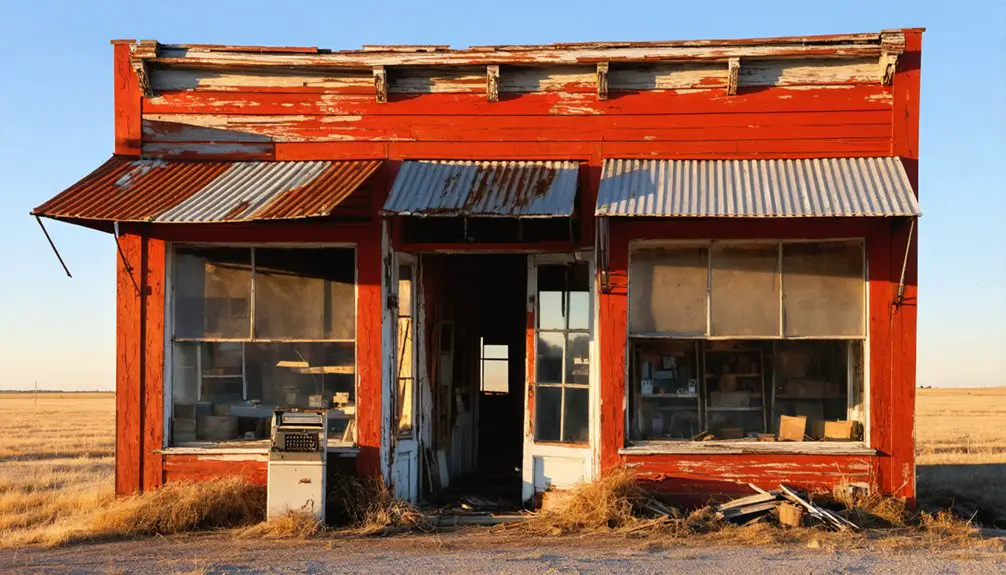
As a minor trade hub along the NorthWestern Railroad, Glen’s commercial identity emerged through its role as a strategic siding town serving local agricultural interests.
You’ll find evidence of local trade and economic sustainability in the two remaining store buildings that once supplied the community’s essential needs.
Glen’s businesses adapted to serve both permanent residents and transient railroad workers with:
- General merchandise stores offering dry goods and groceries
- Cash-based transactions typical of railroad town commerce
- Patent medicines and household necessities
- Agricultural supply services supporting nearby farms
The town’s commercial importance remained closely tied to the railroad’s presence, but as rail traffic declined and transportation patterns shifted to roadways, Glen’s business district gradually faded.
Like many old buildings in Steele City, these historic commercial structures offer visitors a glimpse into Nebraska’s railroad town heritage.
This economic transformation mirrors the fate of other Nebraska ghost towns like Belvidere.
Peak Years and Daily Life
Life in Glen reached its pinnacle in the early 20th century, when several hundred residents called this railroad settlement home.
You’d find farmers and ranchers working from sunrise to sunset, following seasonal rhythms of planting and harvesting. Daily routines revolved around essential stops at the general store, blacksmith shop, and post office.
Community gatherings brought everyone together in the town’s wooden buildings, where you’d join your neighbors at the schoolhouse or hotel common room for social events.
The schoolhouse and hotel served as social hubs, drawing townsfolk together for cherished moments of community connection.
During market days and rodeos, the streets would buzz with activity as folks from surrounding homesteads converged on Glen. You’d see horses and wagons lined up while people conducted business, shared news, and strengthened the bonds that kept this frontier community thriving in Nebraska’s demanding rural environment.
Factors Behind Glen’s Decline
Glen’s decline began sharply when the Burlington Railroad discontinued service to the town, removing its essential transportation link to regional markets and undermining its role as a local trade hub.
You’ll find that once rail service ended, residents began moving away in increasing numbers to larger towns and cities that offered better economic prospects and modern amenities.
The exodus accelerated as agricultural mechanization reduced the need for farm labor, while the consolidation of smaller farms into larger operations further diminished Glen’s population base.
Railroad Service Ended
When railroad service ended in Glen during the late 1970s, the town’s economic foundation crumbled rapidly.
You could see the railroad impact ripple through every aspect of local life as the economic decline took hold. The town’s essential transportation lifeline was severed, devastating local commerce and industry.
Consider these critical losses that sealed Glen’s fate:
- The elimination of rail shipping crippled the town’s agricultural and livestock trade.
- Local timber and coal operations shut down without rail transport.
- Merchants and service providers lost significant business as freight volume disappeared.
- The loss of railroad jobs and passenger service isolated the community.
Major rail companies had deemed Glen’s line unprofitable, and with severe infrastructure damage from flooding, there was no turning back.
Population Exodus Patterns
Multiple forces converged to trigger Glen’s population exodus throughout the late 1970s and early 1980s. You’d have seen distinct population trends emerge as younger residents left for urban opportunities, leaving behind an aging community with declining birth rates.
Migration patterns revealed a steady outflow as families sought better prospects elsewhere. The town’s isolation and harsh four-season climate pushed more residents to relocate near essential services.
Farm consolidation and mechanization eliminated traditional agricultural jobs, while the lack of alternative industries left few employment options. You couldn’t miss how the closure of community institutions – schools, churches, and social clubs – accelerated the exodus.
The combination of absentee property ownership and minimal local investment sealed Glen’s fate, transforming it from a vibrant railroad town into a near-empty prairie settlement.
Agricultural Changes Impact
Agricultural volatility dealt severe blows to Glen’s economic foundation throughout the late 20th century, as evidenced by stark declines in crop revenues and land values.
The region’s farmers struggled with diminishing economic sustainability as rising production costs and interest rates squeezed profit margins. While some attempted crop diversification to weather market fluctuations, many couldn’t sustain operations.
Key factors that accelerated Glen’s agricultural decline:
- Soaring input costs for seeds, fertilizers, and equipment made farming operations increasingly unsustainable.
- Multi-decade high interest rates limited farmers’ ability to maintain or expand operations.
- Reduced precipitation combined with pest challenges compromised crop yields.
- Technology adoption costs favored larger farms, pushing smaller operations toward closure.
These agricultural pressures ultimately contributed to Glen’s transformation into a ghost town, as farming families sought opportunities elsewhere.
Preserving Glen’s Heritage
As efforts to preserve Nebraska’s ghost town heritage intensify, Glen’s historical legacy remains a focal point for archivists and preservationists across the state.
You’ll find community involvement at the heart of preservation techniques, with local historical societies working alongside experts to document and protect what remains of Glen’s past.
The Nebraska State Historical Society‘s been digitizing maps, photographs, and personal accounts while preserving essential records that tell Glen’s story.
You can see their commitment through carefully placed interpretive signage and stabilized structures that follow National Register guidelines.
They’re also securing funding through preservation grants and partnerships with local government agencies, ensuring Glen’s heritage won’t fade into obscurity.
Through educational programs and guided tours, you’re able to connect with this important piece of Nebraska’s past.
Last Residents and Their Stories
The human stories behind Glen’s final chapter offer a poignant glimpse into small-town Nebraska life.
As you explore the remnants of this railroad siding turned ghost town, you’ll find traces of the last families who called Glen home. Their lives centered around agriculture and the railroad until modern transportation shifted the winds of change.
You’ll discover these enduring elements of Glen’s last residents:
- A rural schoolhouse that educated local children until its recent closure
- Family farmsteads where residents maintained their independence through small-scale agriculture
- The old Northwestern Railroad line where residents once earned their living
- A cemetery that tells ghost stories of Glen’s past through weathered headstones
These final inhabitants faced isolation and economic challenges, yet they preserved Glen’s heritage until its conversion to a ghost town.
Surviving Structures Today
Standing amid the Nebraska prairie today, you’ll find Glen’s surviving structures reduced to scattered foundations, partial walls, and weathered remnants of its railroad past.
Scattered stone foundations and crumbling walls emerge from the prairie grass, silent witnesses to Glen’s forgotten railroad legacy.
The town’s layout reveals itself through crumbling commercial and residential foundations, while abandoned railbeds, now converted to hiking trails, trace the town’s former transportation arteries.
You’ll spot surviving artifacts like rusted vehicles and farm equipment partially reclaimed by native vegetation, stark symbols of urban decay.
No operational buildings remain, and utility structures have collapsed into deteriorating masonry remnants.
Prairie grasses and local wildlife have steadily overtaken the site, obscuring many ruins beneath thick vegetation.
What you’re seeing is nature’s persistent reclamation of this once-bustling Nebraska settlement.
Frequently Asked Questions
Are There Any Reported Ghost Sightings or Paranormal Activity in Glen?
You won’t find documented ghostly encounters or official paranormal investigations in Glen. Despite its abandoned buildings and cemetery, there’s no credible evidence of supernatural activity in this former railroad town.
What Are the Nearest Towns Still Inhabited Near Glen Today?
You’ll find a million friendly faces in Albion, just 10 miles southeast of Glen’s remains. Other nearby towns include Neligh (20 miles northeast), Humphrey (15 miles south), and Stanton (25 miles southeast).
Can Visitors Legally Explore the Remaining Buildings in Glen?
You’ll need to obtain legal permissions before exploring any remaining buildings, as access isn’t guaranteed. Following proper exploration guidelines means viewing structures from public areas unless specific authorization’s granted.
What Natural Disasters or Extreme Weather Events Affected Glen Historically?
You’ll find extensive flood damage from White River overflows and likely tornado destruction impacted the area, though specific events aren’t well documented. Harsh winters and droughts also challenged local survival.
Are There Any Annual Events or Reunions Held by Former Glen Residents?
You won’t find any documented reunions or annual gatherings of former Glen residents today. While Nebraska’s ghost towns sometimes inspire local history events, there’s no evidence of specific Glen-focused community meetups.
References
- https://history.nebraska.gov/wp-content/uploads/2017/12/doc_publications_NH1937GhostTowns.pdf
- https://www.ghosttowns.com/states/ne/glen.html
- https://kids.kiddle.co/Glencoe
- https://en.wikipedia.org/wiki/Glencoe
- https://history.nebraska.gov/finding-nebraskas-ghost-towns/
- https://discovernwnebraska.com/railroad/
- https://libraries.ne.gov/scotia/files/2024/07/A-History-of-the-Settlement-of-Scotia-and-Vicinity.pdf
- https://en.wikipedia.org/wiki/First_transcontinental_railroad
- https://history.nebraska.gov/wp-content/uploads/2017/12/doc_publications_NH1948PacificRR.pdf
- https://history.nebraska.gov/wp-content/uploads/2021/05/doc_publications_NH1969UPRailroad.pdf
